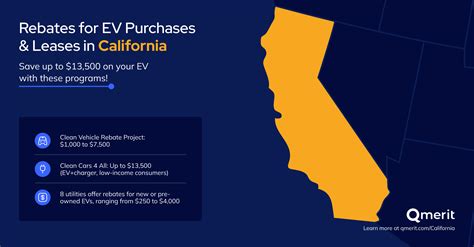California’s Electric Car Revolution: How Rebates are Driving Adoption
California has long been a leader in environmental innovation and energy policies, and its electric car revolution is a prime example of that commitment to sustainability. With the ever-increasing concern about climate change, air quality, and fossil fuel dependency, the state has implemented various incentives designed to encourage residents to switch from traditional gas-powered vehicles to electric alternatives. Among these initiatives, the availability of rebates has proven to be a powerful motivator for both individuals and businesses to invest in electric vehicles (EVs).
The Landscape of Electric Vehicles in California
As of 2023, California boasts the largest market for electric vehicles in the United States, representing nearly half of all EVs sold nationwide. Several factors contribute to this rapid growth, including a robust infrastructure of charging stations, a diverse range of vehicle options, and progressive legislation aimed at reducing greenhouse gas emissions.
Government Incentives: A Driving Force
The state government has enacted various programs aimed at making electric vehicles more affordable. These include the California Clean Vehicle Rebate Project (CVRP), which offers rebates of up to $7,000 for eligible electric vehicles. This financial incentive has played a crucial role in lowering the purchase price, making EVs more accessible to a broader audience.
Additionally, rebates are not limited to individual consumers. Many businesses are also eligible for incentives when they choose to electrify their fleets. This not only reduces operational costs but also contributes to the state’s overall goal of reducing emissions.
Popularity of Electric Vehicles
Data from recent studies indicates that electric vehicle sales in California are surging. With over 800,000 zero-emission vehicles sold in the state by 2022, the trend shows no signs of slowing down. The availability of diverse brands, models, and price points makes it easier for consumers to find a suitable electric vehicle that meets their needs.
Moreover, automakers are increasingly investing in electric vehicle technology. Major companies such as Tesla, General Motors, and Ford have launched or announced plans for expanding their electric lineups, further encouraging consumer adoption.
Infrastructure Improvements
A robust charging infrastructure is critical to encourage EV adoption. California has made extensive investments to ensure that charging stations are widely available throughout the state. The California Energy Commission (CEC) has allocated millions of dollars to install public charging stations, particularly in underserved areas.
Furthermore, many businesses are installing charging stations at their premises to support employees and customers. This expanding network not only alleviates range anxiety for potential EV buyers but also promotes a culture of electric vehicle usage across the state.
Environmental and Economic Impact
The environmental implications of California’s shift towards electric vehicles are profound. By reducing reliance on fossil fuels, the state aims to decrease air pollution and lower greenhouse gas emissions significantly. This shift can lead to improved public health outcomes and reduced healthcare costs associated with vehicle emissions.
Economically, the growth of the electric vehicle market has the potential to create thousands of jobs in manufacturing, infrastructure development, and maintenance services. As more Californians choose electric vehicles, it generates new opportunities within the green economy.
Challenges Persisting in the EV Market
Despite the promising outlook, challenges remain in the transition to electric vehicles. One significant barrier is the upfront cost, which, even with rebates, can still be a hurdle for some consumers. While prices are gradually decreasing, the majority of still expensive models dominate the market.
Additionally, some regions face inadequate charging infrastructure, particularly in rural areas, where access to charging stations is limited. This can lead to “range anxiety,” discouraging potential buyers who may worry about running out of battery life on longer trips.
The Future of Electric Vehicles in California
California has set ambitious goals for the future, aiming to have 1.5 million electric vehicles on the road by 2025. The state has also committed to transitioning to a fully zero-emission vehicle market by 2035. With continued investment in infrastructure and consumer incentives, California is well on its way to meeting these targets.
Conclusion
California’s electric car revolution stands as a testament to the power of government initiatives and consumer interest in sustainable energy. The sophisticated rebate systems, combined with expansive charging infrastructure and a wide selection of electric vehicles, have effectively positioned California at the forefront of the EV movement. As the state pushes towards its ambitious goals for the future, the collective efforts of citizens, businesses, and government agencies will shape a cleaner, more sustainable transportation landscape. As we drive into this electric future, the benefits of cleaner air, economic growth, and a better planet are clear and compelling.
FAQs
1. What are the main incentives for buying an electric vehicle in California?
The main incentives include the California Clean Vehicle Rebate Project (CVRP), which offers rebates of up to $7,000 for eligible electric vehicles, as well as additional incentives for businesses that invest in electric vehicle fleets.
2. How many electric vehicles are currently in California?
As of 2022, there are over 800,000 registered zero-emission vehicles in California, accounting for nearly half of all electric vehicles in the United States.
3. Are there enough charging stations in California?
California has made significant investments in expanding charging station availability; however, some rural areas still face challenges with inadequate infrastructure.
4. What is the state’s goal for electric vehicles by 2035?
California aims to transition to a fully zero-emission vehicle market by 2035, promoting sustainability and reducing greenhouse gas emissions in the state.
5. How do electric vehicles contribute to environmental sustainability?
Electric vehicles reduce reliance on fossil fuels and lower greenhouse gas emissions, leading to improved air quality and decreased public health risks associated with vehicle emissions.
Download California Rebates On Electric Cars
